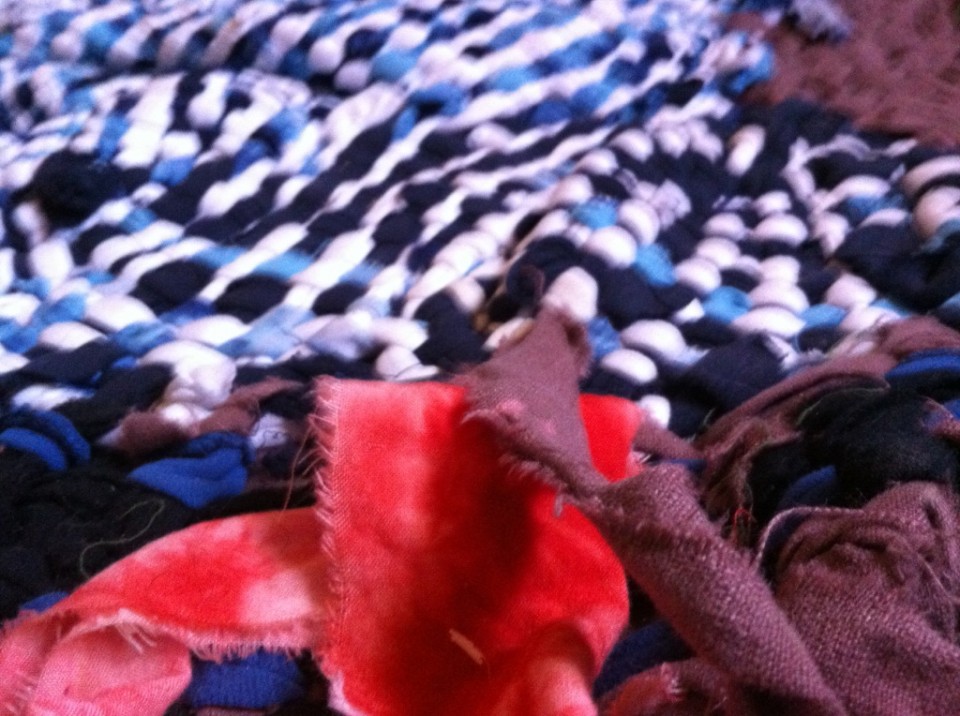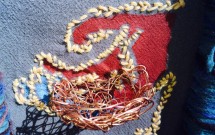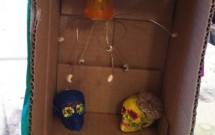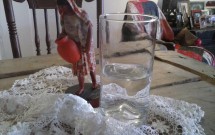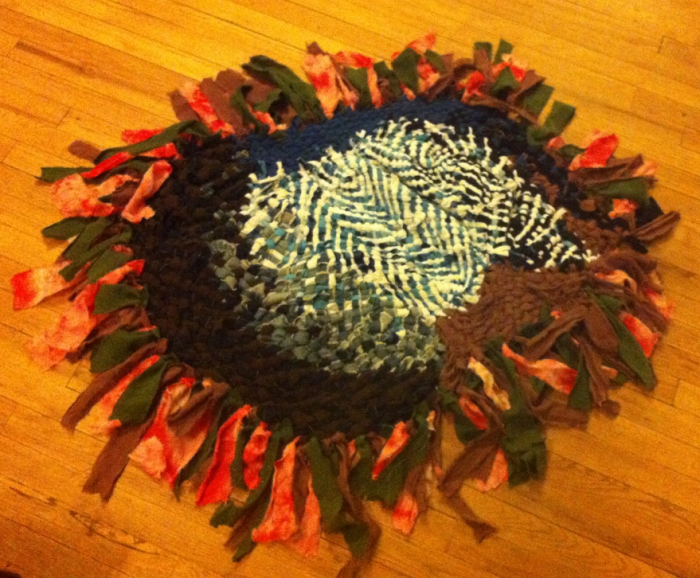
by Magdalena Karlick
I delved into this rag rug project at the beginning of the summer, wanting to recycle old, ill-fitting, and stained clothing to make a rug for my son’s new room. I imagined a place where he could sit comfortably while looking at his books or playing with his toy animals.
Here are a couple of great instructions online that I reviewed.
I tore shirts, pants, jeans, and a dress as I worked. Tearing and cutting, tying and stretching, was extremely viscerally satisfying. I made piles of thread here and there, and imagined the future use of these piles of unraveled thread in paintings. It is amazing how supplies can multiply as they are broken down. I wonder, where is the line between recycling supplies for use in art and hoarding?
Janis Timm-Bottos (2011), in her article “Endangered Threads: Socially Committed Community Art Action,” discusses the importance of recycling, art, and the positive communal effects when the two are brought together. This is an article that I assign in my Current Trends class at Southwestern College, when we discuss how to use recycled materials within the therapeutic milieu. Timm–Bottos, creator of Off Center in Albuquerque, consistently drives the message home that to buy new and to throw away is a threat to our environment. I was re-inspired by this article to only buy clothing from used clothing stores, and to artistically reuse clothing that is not donate-able or trade-able. So, this rag rug is a product of that inspiration.
The majority of the clothing that was used I had really enjoyed wearing, most of it was worn-through and holey material. As I tore and combined pieces, I thought about the type of material that I dress myself in and what my skin wants or enjoys to wear. One of my priorities with clothing, and my body, is comfort. It doesn’t have to accentuate my attractiveness, or articulate a style, it has to encourage a body flow that feels right to my skin, my torso, my hips, my limbs, and my organs.
As I wove the stretchy material with the difficult jean material, I thought about how and where the clothing was worn. I thought about the journey of the material both known to me, as well as before I started my relationship with that piece of clothing.
Half-way through this project, I noticed that the rug started to have bumps, it was not lying flat. It was not turning into what I wanted it to be. I kept working, paying attention to the voice of “this is ugly,” “not good enough,” “give it up.” I met that voice with “this will be good enough,” “this will be soft and comfortable,” and “Judah will like it.”
I have found that the words “this is ugly” or “not good enough” is a part of my creative process. This potentially destructive voice comes in when I am in uncharted territory with the art piece, unsure what it is, or where it will lead me. This voice sometimes leads me to agree and give up.
For clients who engage in Art with me I will often wonder with the client about how they feel about their piece, what happened during the process of creation, and how it relates to their relationship with their self and their life. What voices are the loudest within? Which voice’s volume could be increased? Decreased?
Art Therapists have written about aesthetics within Art Therapy, how both the client’s interpretation as well as the the therapist’s experience of the art is an important aspect of the transference relationship between the two (Schaverien, 2000). I believe that my experience of aesthetics relates to my internal community, and continues to be quite a teacher regarding my relationship to myself (selves) and to my surroundings.
In this case, I finished the rag rug, and I still think it’s unattractive. However, there is a place for “ugly” in art, and in my world, as that is much more real than being attractive or pleasing 100% of the time. And I realize that “real” is more important to me than “pretty” and “pleasing.”
Ugly can be “good enough” or perhaps perfect.
References
Timm-Bottos, Janis (2011). Endangered Threads: Socially Committed Community Art Action. Art Therapy: Journal of the American Art Therapy Association, 28(2), pp. 57-63.
Schaverien, Joy (2000).”The Triangular Relationship and the Aesthestic Countertransference in Analytical Art Psychotherapy,” In Gilroy, A. and McNeilly, G. (eds) The Changing Shape of Art Therapy. London: Jessica Kingsley Publishers.
 Southwestern College Santa Fe, NM
Southwestern College Santa Fe, NM


